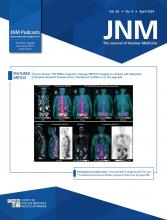Abstract
PET brain imaging of the serotonin 1A (5-hydroxytryptamine 1A [5-HT1A]) receptor has been widely used in clinical studies. Currently, only a few well-validated radiolabeled antagonist tracers are available for in vivo imaging of this central receptor. 5-HT1A receptors exist in high- and low-affinity states, depending on their coupling to G proteins. Agonists bind preferentially to receptors in the high-affinity state and thereby could provide a measure of functional 5-HT1A receptors. Therefore, it is of great interest to develop an 18F-labeled full agonist 5-HT1A receptor radiotracer. In this study, we radiolabeled the high-affinity 5-HT1A receptor agonist 18F-F13714 and investigated its potential as a PET tracer. Methods: F13714 nitro precursor was synthesized and radiolabeled via a fluoronucleophilic substitution. In vitro binding assays were performed using established protocols. Radiopharmacologic evaluations included in vitro autoradiography in rat brain and PET scans on anesthetized cats. Results: The chemical and radiochemical purities of 18F-F13714 were greater than 98%. F13714 has a high affinity (0.1 nM) and selectivity for 5-HT1A receptors. In vitro 18F-F13714 binding in rats was consistent with the known 5-HT1A receptors distribution (hippocampus and cortical areas) and was particularly high in the dorsal raphe. In vitro binding of 18F-F13714 was blocked in a dose-dependent fashion by WAY100635, the prototypical 5-HT1A antagonist, and by the endogenous agonist, serotonin (5-HT). Addition of Gpp(NH)p also inhibited in vitro 18F-F13714 binding, consistent with a preferential binding of the compound to G-protein–coupled receptors. Ex vivo tissue measurements in rat revealed an absence of brain radioactive metabolites. In vivo studies showed that the radiotracer entered the cat brain readily and displayed a preferential labeling of 5-HT1A receptors located in cingulate cortex. In vivo labeling was prevented by preinjection of WAY100635. Conclusion: 18F-F13714 is a radiofluorinated agonist that presents suitable characteristics for probing the high-affinity states of the 5-HT1A receptors in vitro and in vivo. Thus, it is a promising tool for investigation of 5-HT1A agonist binding in the living human brain.
Footnotes
Published online ▪▪▪▪▪▪▪.
- © 2012 by the Society of Nuclear Medicine, Inc.







